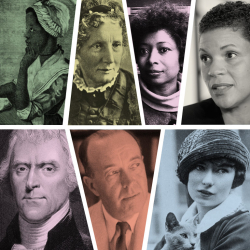Ibram X. Kindi in The New York Times:
 Many Americans might not know the more polemical side of race writing in our history. The canon of African-American literature is well established. Zora Neale Hurston, Richard Wright, James Baldwin are familiar figures. Far less so is Samuel Morton (champion of the obsolete theory of polygenesis) or Thomas Dixon (author of novels romanticizing Klan violence). It is tempting to think that the influence of those dusty polemics ebbed as the dust accumulated. But their legacy persists, freshly shaping much of our racial discourse.
Many Americans might not know the more polemical side of race writing in our history. The canon of African-American literature is well established. Zora Neale Hurston, Richard Wright, James Baldwin are familiar figures. Far less so is Samuel Morton (champion of the obsolete theory of polygenesis) or Thomas Dixon (author of novels romanticizing Klan violence). It is tempting to think that the influence of those dusty polemics ebbed as the dust accumulated. But their legacy persists, freshly shaping much of our racial discourse.
On the occasion of Black History Month, I’ve selected the most influential books on race and the black experience published in the United States for each decade of the nation’s existence — a history of race through ideas, arranged chronologically on the shelf. (In many cases, I’ve added a complementary work, noted with an asterisk.) Each of these books was either published first in the United States or widely read by Americans. They inspired — and sometimes ended — the fiercest debates of their times: debates over slavery, segregation, mass incarceration. They offered racist explanations for inequities, and antiracist correctives. Some — the poems of Phillis Wheatley, the memoir of Frederick Douglass — stand literature’s test of time. Others have been roundly debunked by science, by data, by human experience. No list can ever be comprehensive, and “most influential” by no means signifies “best.” But I would argue that together, these works tell the history of anti-black racism in the United States as painfully, as eloquently, as disturbingly as words can. In many ways, they also tell its present.
1771-1780
“Poems on Various Subjects, Religious and Moral,” by Phillis Wheatley (1773)
No book during the Revolutionary era stirred more debates over slavery than this first-ever book by an African-American woman. Assimilationists and abolitionists exhibited Wheatley and her poetry as proof that an “uncultivated barbarian from Africa” could be civilized, that enslaved Africans “may be refin’d, and join th’ angelic train” of European civilization and human freedom. Enslavers disagreed, and lashed out at Wheatley’s “Poems.”
More here. (Note: At least one post throughout February will be in honor of Black History Month)
Michael Dirda at The Washington Post:
